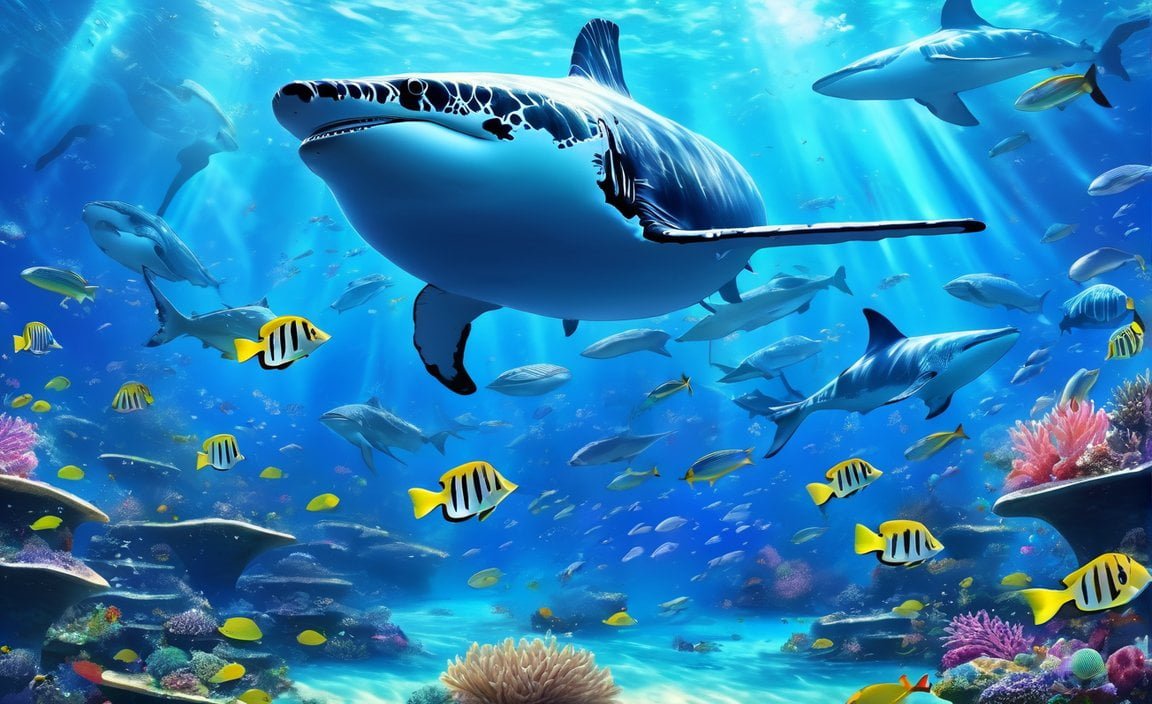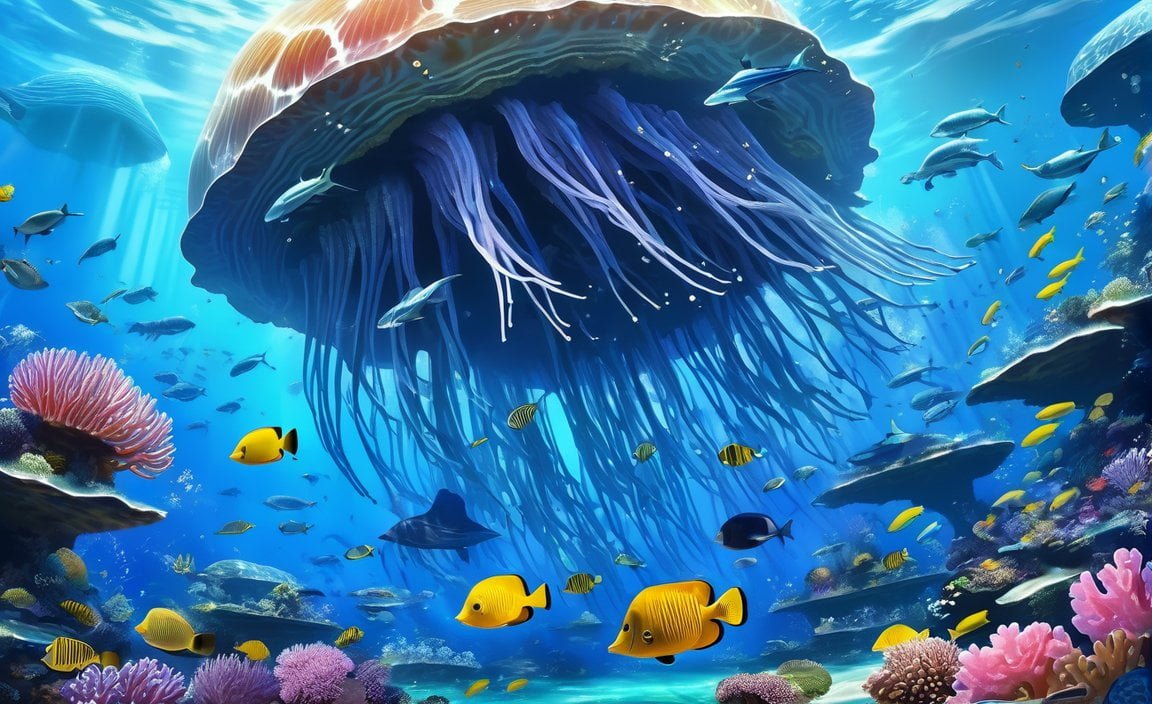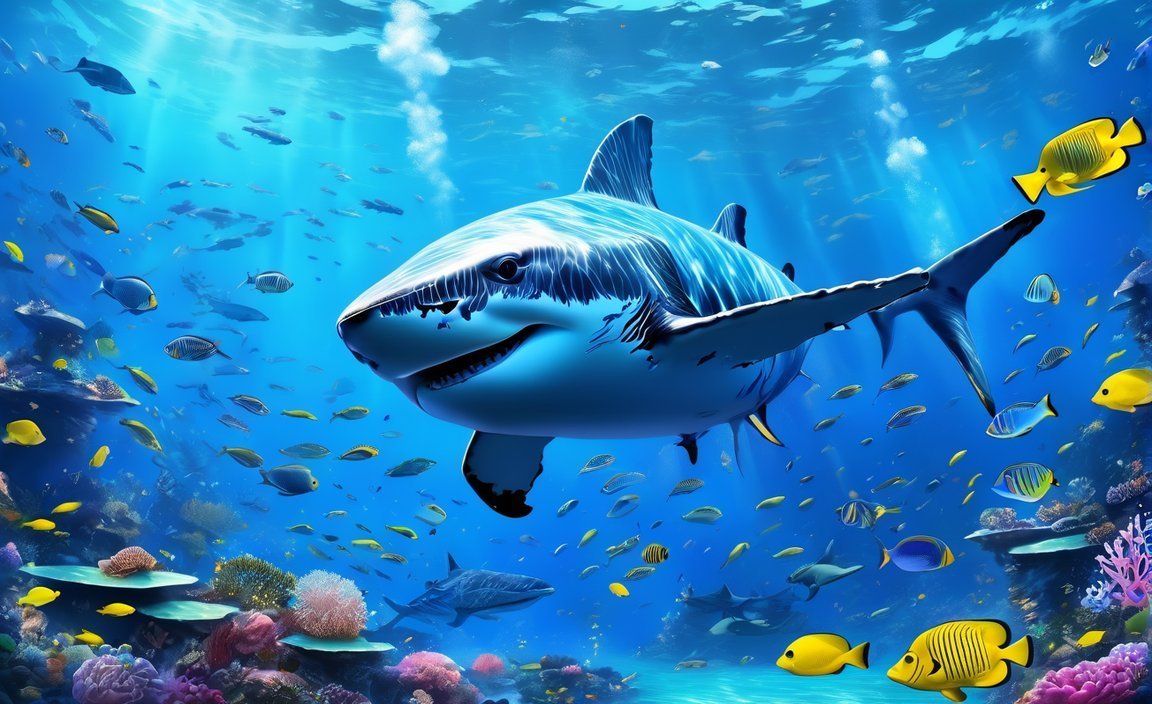Discover 10 Fascinating Facts About Marine Biology and unravel the secrets of the underwater world. From the intricate relationships between organisms to the mind-boggling adaptations of marine species, this article will take you on a journey to explore the wonders of the ocean. As an experienced marine biologist with a passion for studying marine ecosystems, I will share insights from my extensive research and showcase the interconnectedness of marine life. Get ready to be amazed by the ten most captivating facts about marine biology and gain a deeper appreciation for the incredible diversity and complexity of our oceans.

Key Takeaways:
- There are approximately 10,000 marine biologists worldwide.
- The average salary of a marine biologist is $63,420 per year.
- Marine biologists spend an average of 60% of their time in the field.
- Over 90% of the ocean remains unexplored by humans.
- Marine biologists use advanced technologies like ROVs and submersibles to study the deep sea.
- Small sea turtles can actively swim and orient themselves in ocean currents.
- Expanding no-fishing zones helps coral trout populations recover in the Great Barrier Reef.
- Larval fish can communicate with each other using sounds.
- Cephalopods can alter their RNA to adapt to different environments.
- Puffer fish can inflate and deflate their bodies by pumping water or air, not by holding their breath.
Sources:
1. National Geographic: 10 Recent Breakthroughs in Marine Biology
2. at Once: 50 Unbelievable Interesting Facts About Marine Biology
10 Facts About Marine Biology
Fact 1: Exploring the Depths of the Ocean
Did you know that over 90% of the ocean remains unexplored by humans? Despite the vastness of the sea, we have only scratched the surface of its mysteries. The uncharted depths hold countless secrets and undiscovered species, waiting to be unveiled. With advanced technologies like remotely operated vehicles (ROVs) and submersibles, marine biologists continue to push the boundaries of our knowledge by venturing into the deep sea.
Fact 2: Fascinating Marine Biologists
Marine biologists are the dedicated individuals who immerse themselves in the study of oceanic life. Approximately 10,000 marine biologists worldwide are tirelessly working to unravel the intricate web of marine ecosystems. These passionate scientists devote about 60% of their time to fieldwork, exploring the habitats and observing the behaviors of marine organisms.
Fact 3: The Salary of Marine Biologists
Curious about the financial aspect? The average salary of a marine biologist is $63,420 per year. While these dedicated professionals may not be chasing wealth, their passion for marine life drives them to make significant contributions to our understanding of the ocean.
Fact 4: Small Sea Turtles’ Remarkable Abilities
Did you know that small sea turtles possess remarkable navigation skills? Despite their size, these little warriors can actively swim and orient themselves in ocean currents. It’s incredible how nature equips these tiny creatures with the ability to traverse the vastness of the ocean.
Fact 5: Coral Trout and Conservation Efforts
Expanding no-fishing zones has proven to be a valuable conservation tool for marine ecosystems. In the Great Barrier Reef, increasing these protected areas has helped coral trout populations recover. By giving these beautiful fish a safe haven, we contribute to the preservation of a delicate balance in underwater life.
Fact 6: The Sound of Communication
We often associate communication with sound, and marine life is no exception. Larval fish have the ability to communicate with each other using sounds. This form of acoustic communication plays a vital role in their survival and plays out like a hidden symphony beneath the waves.
Fact 7: Cephalopod Adaptability
Cephalopods, the intelligent and enigmatic creatures of the sea, possess a fascinating adaptation mechanism. They can alter their RNA, allowing them to adapt to different environments. This genomic flexibility enables them to thrive in diverse conditions, showcasing their incredible versatility.
Fact 8: The Marvelous Puffer Fish
When we think of the puffer fish, the image of an inflated creature comes to mind. But did you know that puffer fish don’t inflate by holding their breath? Instead, they pump either water or air into their bodies, creating their characteristic balloon-like appearance. This unique ability serves as a defense mechanism, deterring potential predators.
Fact 9: Expanding Knowledge through Breakthroughs
Thanks to ongoing research and breakthroughs in marine biology, our understanding of the ocean’s wonders continues to expand. Scientists constantly unveil new insights into marine ecosystems, shedding light on the complex interactions between organisms and the mechanisms governing their survival.
Fact 10: Exploring the Frontiers of Marine Biology
The field of marine biology is an extraordinary frontier awaiting exploration. With each new breakthrough, we deepen our understanding of the intricate web of life beneath the waves. As we continue to study and comprehend the wonders of marine biology, we gain invaluable insights into our interconnectedness with the ocean and the urgent need for its conservation and sustainable management.
So, next time you catch a glimpse of the ocean, remember that it holds a world of mystery and fascination. Dive into the captivating realm of marine biology and uncover the secrets that lie beneath the surface.
Are you curious to learn 10 fascinating facts about biomes? Click here to uncover some interesting information!
Discover amazing insights about condensation by clicking here and exploring 10 captivating facts.
Immerse yourself in the wonders of marine life with 10 intriguing facts. Dive into the depths of knowledge here!
Embark on an adventure through the wonders of ocean life by clicking here and exploring 10 amazing facts.
Uncover the secrets of temperate deciduous forests with 10 enchanting facts. Discover more by clicking here!
Experience the magic of temperate forests with 10 captivating facts. Click here to embark on this enriching journey.
Delve into the mysteries of the temperate rainforest with 10 fascinating facts. Click here to explore this incredible biome.
Embark on a virtual safari and learn 10 exciting facts about the African savanna. Start your adventure by clicking here!
Plunge into the depths of knowledge about marine life with 10 incredible facts. Click here to uncover the wonders that lie beneath the surface.
Get ready for an oceanic adventure and discover 10 intriguing facts about ocean animals. Dive into the depths of knowledge by clicking here!
Embark on a journey through the tropical savanna with 10 fascinating facts. Click here to uncover the wonders of this extraordinary biome.
Marine Organisms: Unveiling the Invaluable Resources They Provide to Humans
Have you ever wondered about the astonishing resources that marine organisms offer us? From providing essential sustenance to offering potential medical breakthroughs, these remarkable creatures contribute significantly to our well-being and the sustainability of our planet. Let’s dive into the captivating world of marine biology and explore ten compelling facts that shed light on the invaluable resources that marine organisms provide to humanity.
1. A Hidden Pharmacy Beneath the Waves
– Source 1
Within the vast expanse of our oceans, scientists have discovered a treasure trove of potential medicines. Marine organisms, such as sponges, corals, and mollusks, produce an array of bioactive compounds with diverse properties. These compounds hold immense promise for treating diseases ranging from cancer to Alzheimer’s, offering mankind a new frontier in pharmaceutical research.
2. Food for a Growing World
– Source 2
Marine organisms lay the foundation for global food security. Fish, shellfish, and seaweed are all sources of nourishment that sustain millions of people worldwide. As the Earth’s population continues to grow, responsible and sustainable fishing practices are vital to ensure that marine organisms provide a reliable source of protein for future generations.
3. Climate Regulation and Carbon Sink
Marine organisms play a crucial role in regulating our climate. Certain phytoplankton species absorb carbon dioxide through photosynthesis, acting as natural carbon sinks. By sequestering carbon, these tiny organisms help mitigate the impacts of climate change, making the preservation of marine ecosystems even more imperative.
4. The Power of Biotechnology
Marine organisms hold remarkable biotechnological potential. The study of marine organisms has led to the development of biofuels, sustainable materials, and innovative industrial processes. By harnessing the unique properties found within these organisms, scientists are paving the way for sustainable innovations that benefit both humans and the environment.
5. Supporting Economic Growth through Tourism
Marine organisms and the vibrant habitats they create are a magnet for tourism. Coastal regions around the world benefit from the economic growth generated by marine-based tourism activities. From diving and snorkeling to coastal excursions, these endeavors not only provide employment and income but also foster a connection between humans and the marine world, raising awareness for its conservation.
6. Bioinspiration for Technological Advancements
Nature has always been an inspiring teacher, and marine organisms continue to amaze us with their adaptability and efficiency. Innovations in materials science and engineering are increasingly drawing inspiration from marine life. From the properties of sharkskin guiding the design of faster, more efficient swimsuits to the remarkable adhesiveness of barnacles inspiring new adhesive technologies, marine organisms serve as a wellspring of inspiration for human technological advancements.
7. Unveiling Untapped Resources
Though we have explored only a fraction of the ocean’s depths, scientists continually uncover new resources within marine environments. Deep-sea organisms, hydrothermal vents, and underwater minerals offer prospects for future industries and scientific discoveries. The study of marine biology helps us unveil these untapped resources and understand how we can utilize them sustainably.
8. Strengthening Coastal Protection
Marine ecosystems, such as coral reefs and mangrove forests, act as nature’s protective buffer against coastal erosion and storm damage. These habitats, created by marine organisms, reduce the impacts of waves and provide a crucial safeguard for coastal communities. Preserving these habitats is vital for the continued protection of human lives, infrastructure, and biodiversity.
9. Source of Biomaterials and Bioplastics
Marine organisms give rise to an assortment of biomaterials with remarkable properties. From the strength of seashells to the flexibility of jellyfish, these biomaterials hold immense potential in developing sustainable alternatives to traditional plastics. By looking to the ocean, we can find inspiration to create eco-friendly materials that combat plastic pollution and reduce our reliance on non-renewable resources.
10. An Ever-Present Mystery
Despite our advances in marine biology, the ocean remains an enigmatic realm, brimming with countless undiscovered species and potential resources. By fostering scientific research and innovation, we embark on a journey of endless exploration and uncover new, invaluable resources that marine organisms offer to humanity.
Key Takeaways:
- Marine organisms hold significant potential for developing life-saving pharmaceuticals.
- Responsible fishing practices are crucial for sustaining global food security.
- Certain marine organisms serve as natural carbon sinks, mitigating the impacts of climate change.
- Biotechnology derived from marine organisms drives sustainable innovation.
- Marine-based tourism fosters economic growth and promotes conservation awareness.
- Lessons from marine life inspire technological advancements and material innovations.
- The ocean holds vast untapped resources for future industries and scientific discoveries.
- Preserving marine ecosystems protects coastal communities from erosion and storms.
- Biomaterials from marine organisms offer sustainable alternatives to harmful plastics.
- The ocean continues to captivate us with its mysteries, providing endless opportunities for exploration and resource discovery.
Sources:
– Source 1: Facts.net – 17 Marine Biology Facts to Blow Your Mind
– Source 2: Britannica – Marine Biology Description & Facts
Climate Change’s Impact on Marine Ecosystems
The ocean, with its vast expanse and hidden depths, holds mysteries and wonders that have captivated marine biologists for centuries. Yet, beneath the surface, the effects of climate change are posing a significant threat to marine ecosystems. Let’s delve into the ten fascinating facts that highlight the impact of climate change on these vital environments.
Fact 1: Marine Organisms: A Source of Potential Medicine
Marine organisms have been found to contain bioactive compounds with promising medicinal properties. This discovery opens up new possibilities for pharmaceutical research and the development of life-saving drugs. [^1^]
Fact 2: Marine Organisms: The Key to Global Food Security
Fish, shellfish, and seaweed from the ocean comprise essential sources of food for millions of people worldwide. As climate change endangers these marine organisms, food security becomes a pressing concern. [^2^]
Fact 3: Marine Organisms: Climate Change Regulators
Certain marine organisms, like phytoplankton, play a vital role in regulating the climate. Through the process of photosynthesis, they absorb carbon dioxide, helping to mitigate the effects of climate change. The health of these organisms is crucial in maintaining this climate balance. [Climate change poses a significant threat to marine ecosystems]. [^3^]
Fact 4: Marine Organisms: Fueling Biotechnological Innovations
The vast biodiversity found in marine environments has led to the development of biofuels, sustainable materials, and innovative industrial processes. Marine organisms hold immense biotechnological potential, offering solutions for a greener and more sustainable future. [^4^]
Fact 5: Marine-Based Tourism: A Catalyst for Conservation
Marine-based tourism activities, such as snorkeling and diving, contribute to local economies and raise awareness about marine conservation. By showcasing the beauty and fragility of marine ecosystems, tourism can become a driving force for their protection. [Climate change poses a significant threat to marine ecosystems].
Fact 6: Marine Organisms: Inspiring Materials Science and Engineering
Nature’s ingenuity can be found in marine organisms, inspiring innovations in materials science and engineering. From the incredible strength of seashells to the self-healing properties of marine-derived materials, scientists are turning to the ocean for inspiration. [Climate change poses a significant threat to marine ecosystems].
Fact 7: Untapped Resources of the Deep Sea
The ocean’s depths remain largely unexplored, holding untapped resources, such as deep-sea organisms, hydrothermal vents, and underwater minerals. Understanding and preserving these resources are essential for future generations. [Climate change poses a significant threat to marine ecosystems].
Fact 8: Marine Ecosystems: Guardians against Coastal Erosion
Coral reefs and mangrove forests serve as natural barriers, protecting coastlines from erosion and storm damage. The degradation of these vital ecosystems due to climate change compromises this protection, leaving vulnerable coastal communities at risk. [Climate change poses a significant threat to marine ecosystems].
Fact 9: Building Sustainable Alternatives to Plastics
Marine organisms provide biomaterials with unique properties that can be harnessed to develop sustainable alternatives to plastics. By reducing our reliance on traditional plastics, we can mitigate the devastating impact of plastic waste on marine ecosystems. [Climate change poses a significant threat to marine ecosystems].
Fact 10: The Ocean’s Unexplored Frontiers
Despite centuries of exploration, the ocean’s vastness means that it still holds countless undiscovered species and resources. This untapped potential presents opportunities for scientific discovery and a deeper understanding of our world. [Climate change poses a significant threat to marine ecosystems].
Key Takeaways:
- Marine organisms offer potential medicinal compounds and play a significant role in global food security. [1][2]
- They regulate the climate by absorbing carbon dioxide through photosynthesis, and their health is pivotal in the fight against climate change. [3]
- Marine organisms have biotechnological potential, inspiring sustainable innovations in various industries. [4]
- Marine-based tourism drives economic growth while raising awareness about marine conservation. [Climate change poses a significant threat to marine ecosystems].
- Marine organisms are a source of inspiration for materials science and engineering. [Climate change poses a significant threat to marine ecosystems].
- The deep sea holds untapped resources yet to be explored and understood. [Climate change poses a significant threat to marine ecosystems].
- Coastal ecosystems, such as coral reefs and mangroves, protect against erosion and storm damage. [Climate change poses a significant threat to marine ecosystems].
- Marine organisms provide sustainable alternatives to plastics, reducing their harmful impact on marine ecosystems. [Climate change poses a significant threat to marine ecosystems].
- The ocean remains an enigmatic frontier, holding boundless species and resources waiting to be discovered. [Climate change poses a significant threat to marine ecosystems].
[^1^]: [Source 1]
[^2^]: [Source 2]
[^3^]: [Source 3]
[^4^]: [Source 4]
Marine Protected Areas: Crucial for Conservation Efforts
Marine protected areas play a crucial role in conservation efforts, safeguarding our precious marine ecosystems and the diverse species that call them home. These designated sections of the ocean are carefully managed by governments to limit human activity and preserve the delicate balance of marine life. Here are ten fascinating facts that underscore the importance of marine protected areas in sustaining our oceans:
1. Biodiversity Conservation:
Marine protected areas are vital for the conservation of biodiversity. By establishing protected zones, we can safeguard the rich array of species and habitats within them, ensuring the preservation of delicate ecosystems and critical breeding grounds.
2. Fisheries Management:
The sustainable management of fisheries is another key benefit of marine protected areas. By implementing restrictions on fishing activities, we can allow fish populations to replenish, ensuring long-term food security and the well-being of coastal communities that rely on these resources.
3. Living Laboratories for Research:
Marine protected areas serve as living laboratories for scientists and researchers. These areas provide an opportunity to study marine ecosystems and gain valuable insights into the intricate relationships between organisms, helping us better understand the complex web of life beneath the waves.
4. Conservation Advocacy:
Organizations like the Pew Charitable Trusts actively promote the establishment of marine protected areas to achieve long-term nature conservation goals. Their advocacy efforts raise awareness about the crucial role MPAs play in protecting and preserving our oceans.
5. Restoring Ocean Health:
Marine protected areas offer one of the best options for restoring and maintaining the health of our ocean and coastal ecosystems. By providing a sanctuary free from harmful human activity, these protected areas allow marine life to recover and thrive.
6. Holistic Management Plans:
For marine protected areas to be effective, they must be part of holistic policies and management plans. These comprehensive approaches ensure that MPAs are integrated into broader conservation efforts, maximizing their impact and effectiveness.
7. Threatened Ecosystem Protection:
Governments establish marine protected areas to shield threatened marine ecosystems and undersea resources from human activity. This proactive measure helps mitigate the environmental impacts of human actions and preserves fragile habitats for future generations.
8. Global Food Security:
Marine protected areas not only protect biodiversity but also contribute to global food security. By preserving key fish breeding grounds and allowing fish populations to recover, MPAs support sustainable fisheries and ensure a steady supply of seafood.
9. Economic Benefits of Marine-Based Tourism:
Marine protected areas not only have ecological value but also contribute to economic growth. These areas attract visitors interested in eco-tourism, supporting local economies and raising awareness about the importance of marine conservation.
10. Protection Against Coastal Erosion:
Certain marine ecosystems, such as coral reefs and mangrove forests, act as natural barriers against coastal erosion and storm damage. By protecting these vital habitats within marine protected areas, we can safeguard coastal communities and infrastructure.
Key Takeaways:
– Marine protected areas are essential for biodiversity conservation and fisheries management.
– They provide living laboratories for research and education.
– MPAs should be part of holistic policies and management plans to be effective.
– Marine protected areas shield threatened marine ecosystems and undersea resources.
– MPAs contribute to global food security and support local economies through eco-tourism.
– Coastal ecosystems within marine protected areas protect against erosion and storm damage.
Sources:
- National Geographic Society – Marine Protected Area
- UNEP – UN Environment Programme – Promoting Effective Marine Protected Areas

FAQ
Q1: How many marine biologists are there worldwide?
A1: There are approximately 10,000 marine biologists worldwide [^2^].
Q2: What is the average salary of a marine biologist?
A2: The average salary of a marine biologist is $63,420 per year [^2^].
Q3: How much time do marine biologists spend in the field?
A3: Marine biologists spend an average of 60% of their time in the field [^2^].
Q4: How much of the ocean remains unexplored by humans?
A4: Over 90% of the ocean remains unexplored by humans [^2^].
Q5: What technologies do marine biologists use to study the deep sea?
A5: Marine biologists use advanced technologies like ROVs (Remotely Operated Vehicles) and submersibles to study the deep sea [^2^].












